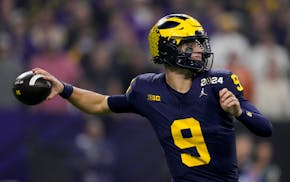The Hazeltine National Golf Club that's home to patriotic pageantry for three days starting Friday is not exactly the one from major championship lore that you or Phil Mickelson might remember.
Site of a U.S. Open and two PGA Championships in the past 25 years, Hazeltine National's 18 holes have been rerouted since unknown Y.E. Yang snatched the PGA trophy away from Tiger Woods in 2009.
A five-hole stretch from each opening and closing nine have been flopped with the other just for the Ryder Cup, the biennial match-play showdown between the United States and Europe that brings its own requirements.
Holes previously played by the club's membership and major championship fields as Nos. 5 through 9 will now be the Ryder Cup's finishing holes 14 through 18, and vice versa.
The change puts fans departing the matches' final holes — wherever they might end — by the thousands each afternoon closer to buses that transport them back to their vehicles. It also will allow galleries to gather en masse in natural amphitheaters around the final four holes, unlike the original water-bound No. 16 or wooded par-3 No. 17.
It also allowed the PGA of America to sell more corporate tents along the new finishing holes, particularly the new par-5 16th hole that, just like the new No. 15, is a "risk-reward" hole compelling in match play because of a pond fronting the green.
The new configuration means the memorable par-4 hole Hazeltine Lake surrounds on three sides is no longer the climatic 16th hole.
Now it's No. 7, which at least means every match foursome, four-ball and singles match will reach it those three days.
"It's a shame because 16 is a great hole," said Englishman and four-time Ryder Cup player Luke Donald, who won the 1999 NCAA individual title at Hazeltine but won't play for Europe this time, "and it could come down to that."
Some things, though, haven't changed at all. If U.S. captain Davis Love III and PGA of America chief championships officer Kerry Haigh so decide, three of Hazeltine's par-5 holes can play longer than 600 yards.
"It's still a big golf course," said Mickelson, who played there in the 1991 U.S. Open at age 20.
The question is whether Love, as the home captain, will shorten the par-5s and order the rough mowed down so his big hitters such as Dustin Johnson, Brooks Koepka and J.B. Holmes can reach greens in two shots, hoping birdies and eagles will energize — and amplify —the fervent American crowd.
"I always say I want to see home runs when I go to the game, I want to see goals scored," Love said. "Defense is great, but we want it to be exciting."
That said, will Love embrace statistical analytics that say his team's true strength is its wedge play and set those par-5s near full length, playing them as three-shot holes to maximize the aim of Mickelson, Jordan Spieth, Brandt Snedeker and Patrick Reed, among others?
Home-course advantage or not, each team plays the same course.
"Before I play, I can't tell you if it's better or worse," European star and defending British Open champion Henrik Stenson said. "But I guess that's all irrelevant. We're going to play them the way they're set up. They're still going to be receptive to good golf shots and putts, I'm sure."
Just how each hole plays matters, but what about the sequence in which they are played?
"They're still the same holes," said Johnson, the defending U.S. Open champ. "It doesn't matter what the number is. That's not going to make any difference. You've still got to play them all. Well, hopefully not all of them."
Joel Embiid scores 50 points to lead 76ers past Knicks 125-114 to cut deficit to 2-1
Vikings trade up twice in NFL draft. They take Michigan QB J.J. McCarthy, Alabama edge Dallas Turner

